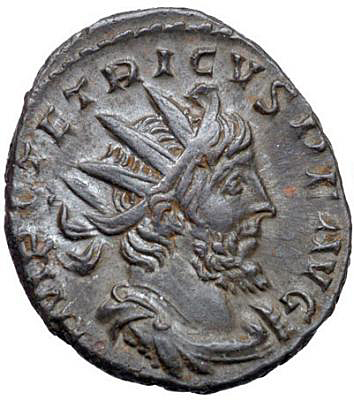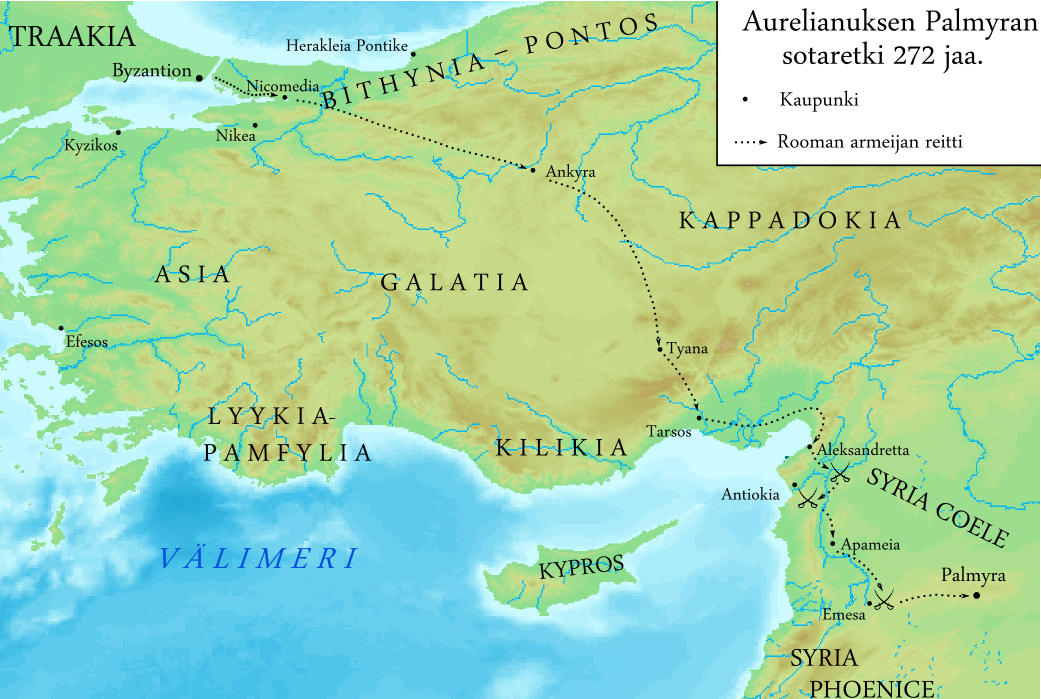|
274
Year 274 (Roman numerals, CCLXXIV) was a common year starting on Thursday of the Julian calendar. At the time, it was known as the Year of the Consulship of Aurelianus and Capitolinus (or, less frequently, year 1027 ''Ab urbe condita''). The denomination 274 for this year has been used since the early medieval period, when the Anno Domini calendar era became the prevalent method in Europe for naming years. Events By place Roman Empire * Battle of Châlons (274), Battle of Châlons: The Emperor Aurelian invades Gaul to campaign against the Gallic Empire (Gaul and Britannia, Britain). In the Catalaunian Plains, the Romano-Gallic Emperor Tetricus I surrenders to Aurelian and leaves his army without an emperor. The Gallic army is then crushed by Aurelian in a major battle. With the conquests of the Palmyrene Empire and the Gallic Empire, the Roman Empire is united again. However, the heavy losses incurred by the Gallic forces compromises the Rhine frontier. * Ancient Rome, R ... [...More Info...] [...Related Items...] OR: [Wikipedia] [Google] [Baidu] |
Tetricus I
Gaius Pius Esuvius Tetricus was a Gallo-Roman culture, Gallo-Roman nobleman who ruled as Augustus, emperor of the Gallic Empire from 271 to 274 AD. He was originally the (provincial governor) of Gallia Aquitania and became emperor after the murder of Emperor Victorinus in 271, with the support of Victorinus's mother, Victoria (Gallic Empire), Victoria. During his reign, he faced external pressure from Germanic peoples, Germanic raiders, who pillaged the eastern and northern parts of his empire, and the Roman Empire, from which the Gallic Empire had seceded. He also faced increasing internal pressure, which led him to declare his son, Tetricus II, in 273 and possibly co-emperor in 274, although this is debated. The Roman emperor Aurelian invaded in 273 or 274, leading to the Battle of Châlons (274), Battle of Châlons, at which Tetricus surrendered. Whether this capitulation was the result of a secret agreement between Tetricus and Aurelian or that surrender was necessary after h ... [...More Info...] [...Related Items...] OR: [Wikipedia] [Google] [Baidu] |
Gallic Empire
The Gallic Empire or Gallo-Roman Empire are names used in modern historiography for a secession, breakaway part of the Roman Empire that functioned ''de facto'' as a separate state from 260 to 274. It originated during the Crisis of the Third Century, when a series of Roman military leaders and aristocrats Roman usurpers, declared themselves emperors and took control of Roman Gaul, Gaul and adjacent provinces without attempting to conquer Roman Italy, Italy or otherwise seize the central Roman administrative apparatus. The Gallic Empire was established by Postumus in 260 in the wake of barbarian invasions and instability in Rome, and at its height included the territories of Germania, Gaul, Roman Britain, Britannia, and (for a time) Hispania. After Postumus' assassination in 269 it lost much of its territory, but continued under a number of emperors and usurpers. It was retaken by Roman emperor Aurelian after the Battle of Châlons (274), Battle of Châlons in 274. History Origin ... [...More Info...] [...Related Items...] OR: [Wikipedia] [Google] [Baidu] |
Battle Of Châlons (274)
In the Battle of Châlons, fought in 274 on the site of modern Châlons-en-Champagne, France, Roman Emperor Aurelian defeated Emperor Tetricus I of the Gallic Empire, whose territories were rejoined with the Roman Empire after fourteen years of separation. Background Aurelian, having subdued revolts in the eastern Roman Empire, began preparing to reconquer the Gallic Empire by early 274. Meanwhile, Tetricus' hold on his domain was steadily weakening, facing continuous raids from Germanic tribes and internal troubles with the rebellion of Faustinus, a provincial governor. Tetricus ordered his troops to leave the Rhine and march southward, where they met the Roman army in the Catalunian fields of Châlons-sur-Marne. Battle Aurelian's army was better trained and well commanded, and when Tetricus was captured in the midst of the fighting, the Rhine army disintegrated and was torn apart by Aurelian's troops. The battle was remembered for years for its high death toll. Afterma ... [...More Info...] [...Related Items...] OR: [Wikipedia] [Google] [Baidu] |
Sol Invictus
Sol Invictus (, "Invincible Sun" or "Unconquered Sun") was the official Solar deity, sun god of the late Roman Empire and a later version of the god Sol (Roman mythology), Sol. The emperor Aurelian revived his cult in 274 AD and promoted Sol Invictus as the chief god of the empire. From Aurelian onward, Sol Invictus often appeared on imperial coinage, usually shown wearing a sun crown and driving a horse-drawn chariot through the sky. His prominence lasted until the emperor Constantine the Great, Constantine I legalized Christianity and restricted paganism. The last known inscription referring to Sol Invictus dates to AD 387, although there were enough devotees in the fifth century that the Christian theologian Augustine of Hippo, Augustine found it necessary to preach against them. In recent years, the scholarly community has become divided on Sol between traditionalists and a growing group of revisionists. In the traditional view, ''Sol Invictus'' was the second of two dif ... [...More Info...] [...Related Items...] OR: [Wikipedia] [Google] [Baidu] |
Tetricus II
Gaius Pius Esuvius Tetricus, better known as Tetricus II, was the son and heir of Tetricus I, emperor of the Gallic Empire from 271 to 274 AD. In 273, he was given the title of ''Caesar'' alongside that of '' princeps iuventutis'', and in January 274 he started his first consulship, together with his father. After the defeat and deposition of his father in the autumn of 274 by the Emperor Aurelian, he and his father appeared as prisoners in Aurelian Aurelian (; ; 9 September ) was a Roman emperor who reigned from 270 to 275 AD during the Crisis of the Third Century. As emperor, he won an unprecedented series of military victories which reunited the Roman Empire after it had nearly disinte ...'s triumph, but the emperor spared their lives. According to some sources, Tetricus II also kept his senatorial rank. Aurelius Victor, ''Liber de Caesaribus'', 35.5. References External links * Polfer, Michael, "Tetricus II (Caesar 273-274 AD)", ''De Imperatoribus Romanis'' ... [...More Info...] [...Related Items...] OR: [Wikipedia] [Google] [Baidu] |
Aurelian
Aurelian (; ; 9 September ) was a Roman emperor who reigned from 270 to 275 AD during the Crisis of the Third Century. As emperor, he won an unprecedented series of military victories which reunited the Roman Empire after it had nearly disintegrated under the pressure of barbarian invasions and internal revolts. Born in modest circumstances, most likely in Moesia, Moesia Superior, he entered the Roman army in 235 and climbed up the ranks. He went on to lead the cavalry of the emperor Gallienus, until Gallienus' Gallienus#Assassination, assassination in 268. Following that, Claudius Gothicus became emperor until his own death in 270. Claudius' brother Quintillus then ruled for three months, before Aurelian took the empire for himself. Aurelian was chosen Roman emperor by the Illyrians, Illyriciani as one of themselves. During his reign, he defeated the Alamanni after a devastating war. He also defeated the Goths, Vandals, Juthungi, Sarmatians, and Carpi (people), Carpi. Aurelian ... [...More Info...] [...Related Items...] OR: [Wikipedia] [Google] [Baidu] |
Zenobia
Septimia Zenobia (Greek: Ζηνοβία, Palmyrene Aramaic: , ; 240 – c. 274) was a third-century queen of the Palmyrene Empire in Syria. Many legends surround her ancestry; she was probably not a commoner, and she married the ruler of the city, Odaenathus. Her husband became king in 260, elevating Palmyra to supreme power in the Near East by defeating the Sasanian Empire of Persia and stabilizing the Roman East. After Odaenathus' assassination, Zenobia became the regent of her son Vaballathus and held de facto power throughout his reign. In 270, Zenobia launched an invasion that brought most of the Roman East under her sway and culminated with the annexation of Egypt. By mid-271 her realm extended from Ancyra, central Anatolia, to Upper Egypt, although she remained nominally subordinate to Rome. However, in reaction to the campaign of the Roman emperor Aurelian in 272, Zenobia declared her son emperor and assumed the title of empress, thus declaring Palmyra's secession f ... [...More Info...] [...Related Items...] OR: [Wikipedia] [Google] [Baidu] |
Hyperinflation
In economics, hyperinflation is a very high and typically accelerating inflation. It quickly erodes the real versus nominal value (economics), real value of the local currency, as the prices of all goods increase. This causes people to minimize their holdings in that currency as they usually switch to more stable foreign currencies. Effective capital controls and currency substitution ("dollarization") are the orthodox solutions to ending short-term hyperinflation; however, there are significant social and economic costs to these policies. Ineffective implementations of these solutions often exacerbate the situation. Many governments choose to attempt to solve structural issues without resorting to those solutions, with the goal of bringing inflation down slowly while minimizing social costs of further economic shocks; however, this can lead to a prolonged period of high inflation. Unlike low inflation, where the process of rising prices is protracted and not generally noticeab ... [...More Info...] [...Related Items...] OR: [Wikipedia] [Google] [Baidu] |
Monotheism
Monotheism is the belief that one God is the only, or at least the dominant deity.F. L. Cross, Cross, F.L.; Livingstone, E.A., eds. (1974). "Monotheism". The Oxford Dictionary of the Christian Church (2 ed.). Oxford: Oxford University Press. A distinction may be made between exclusive monotheism, in which the one God is a singular existence, and both inclusive and pluriform monotheism, in which multiple gods or godly forms are recognized, but each are postulated as extensions of the same God. Monotheism is distinguished from henotheism, a religious system in which the believer worships one god without denying that others may worship different gods with equal validity, and monolatry, monolatrism, the recognition of the existence of many gods but with the consistent worship of only one deity. The term ''monolatry'' was perhaps first used by Julius Wellhausen. Monotheism characterizes the traditions of Abrahamic religions, Abrahamic religions such as Judaism, Samaritanism, Christi ... [...More Info...] [...Related Items...] OR: [Wikipedia] [Google] [Baidu] |
Temple Of The Sun (Rome)
The Temple of the Sun was a temple in the Campus Agrippae in Rome. It was dedicated to Sol Invictus on 25 December 274 by the emperor Aurelian to fulfill a vow he made following his successful campaign against Palmyra in 272 and funded by spoils from that campaign. A college of '' pontifices (Dei) Solis'' and annual games with circus races was established for the cult, as well as four-year games (''agon Solis'') to be held at the end of the Saturnalia. The temple was located in the Regio VII Via Lata. It was decorated with the spoils of war taken from Palmyra and was praised in the ancient sources for its beauty. Although it stood to the east of the via Lata, its exact location is not certain. Near the temple was a porticus where wine was stored. Aurelian had decided that in the future the Roman citizens would also receive free wine and pork from the state in addition to bread and other foodstuffs. This suggests that the temple must have stood in the immediate vicinity of the C ... [...More Info...] [...Related Items...] OR: [Wikipedia] [Google] [Baidu] |
Roman Empire
The Roman Empire ruled the Mediterranean and much of Europe, Western Asia and North Africa. The Roman people, Romans conquered most of this during the Roman Republic, Republic, and it was ruled by emperors following Octavian's assumption of effective sole rule in 27 BC. The Western Roman Empire, western empire collapsed in 476 AD, but the Byzantine Empire, eastern empire lasted until the fall of Constantinople in 1453. By 100 BC, the city of Rome had expanded its rule from the Italian peninsula to most of the Mediterranean Sea, Mediterranean and beyond. However, it was severely destabilised by List of Roman civil wars and revolts, civil wars and political conflicts, which culminated in the Wars of Augustus, victory of Octavian over Mark Antony and Cleopatra at the Battle of Actium in 31 BC, and the subsequent conquest of the Ptolemaic Kingdom in Egypt. In 27 BC, the Roman Senate granted Octavian overarching military power () and the new title of ''Augustus (title), Augustus'' ... [...More Info...] [...Related Items...] OR: [Wikipedia] [Google] [Baidu] |
Common Year Starting On Thursday
A common year starting on Thursday is any non-leap year (i.e. a year with 365 days) that begins on Thursday, 1 January, and ends on Thursday, 31 December. Its dominical letter hence is D. The most recent year of such kind was 2015, and the next one will be 2026 in the Gregorian calendar or, likewise, 2021 and 2027 in the obsolete Julian calendar, see below for more. This is the only common year with three occurrences of Friday the 13th: those three in this common year occur in February, March, and November. Leap years starting on Sunday share this characteristic, for the months January, April and July. From February until March in this type of year is also the shortest period (one month) that runs between two instances of Friday the 13th. Additionally, this is the one of only two types of years overall where a rectangular February is possible, in places where Sunday is considered to be the first day of the week. Common years starting on Friday share this characteristic ... [...More Info...] [...Related Items...] OR: [Wikipedia] [Google] [Baidu] |






